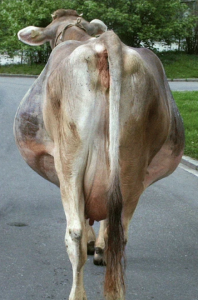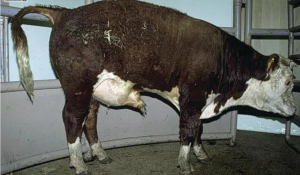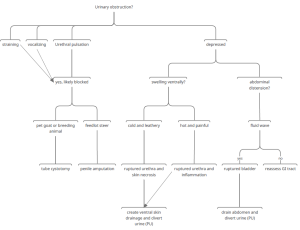Bladder, Urethra and Ureters
Ruptured urethras
The most common cause of ruptured urethra in a ruminant is urolithiasis. In horses, the most common cause is trauma. Ruptured urethras are rare in camelids and swine.
When the urethra ruptures, the fluid leaks subcutaneously along the ventral abdomen creating a large ventral plaque. Urine is irritating so signs of inflammation will be detected early with urethral rupture; later necrosis is more evident.
Animals are often febrile with pain related elevated heart rates and respiratory rates.
Horses
Urethral rupture is rare in horses and is usually related to a kick in the perineal region or to accidental trauma during castration. Treatment goals are the same as for cattle. Diagnosis can be more challenging as the kick injury may not have been witnessed and signs are often not evident for several days. See equine hematuria
Ruminants
As the stones lodge in the urethra, they can cause local damage (pressure necrosis). The force of urination can lead to rupture at the damaged site. The early signs of urethral obstruction can easily be missed in feedlot cattle; often the animals present with urethral rupture. Urethral flushing or forceful bladder compression can also rupture the urethra. This is much easier to do in small ruminants than in small animals. It may be a combination of weaker urethral wall due to the sigmoid flexure and chronicity of the stones. AVOID flushing the urethra in goats!
Subcutaneous urine is very irritating. Animals often develop a fever and skin necrosis from the urine. As urine gravitates ventrally, a plaque of edema will develop around the prepuce. This eventually leads to cold, leathery skin in the area.
Treatment
- avoid more urine leakage – divert urine via a tube cystotomy or perineal urethrotomy
- release the urine that is collecting subcutaneously – incise the skin to allow drainage
- reduce the inflammation – NSAID therapy
Animals cannot be shipped for meat until the uremia resolves. Pet animals can recover with proper treatment. The urethral rupture will usually heal via second intention closure.
Ruptured bladder (left) vs ruptured urethra (right)


https://veteriankey.com/bovine-urolithiasis/
Urinary obstruction flowchart- downloadable version


